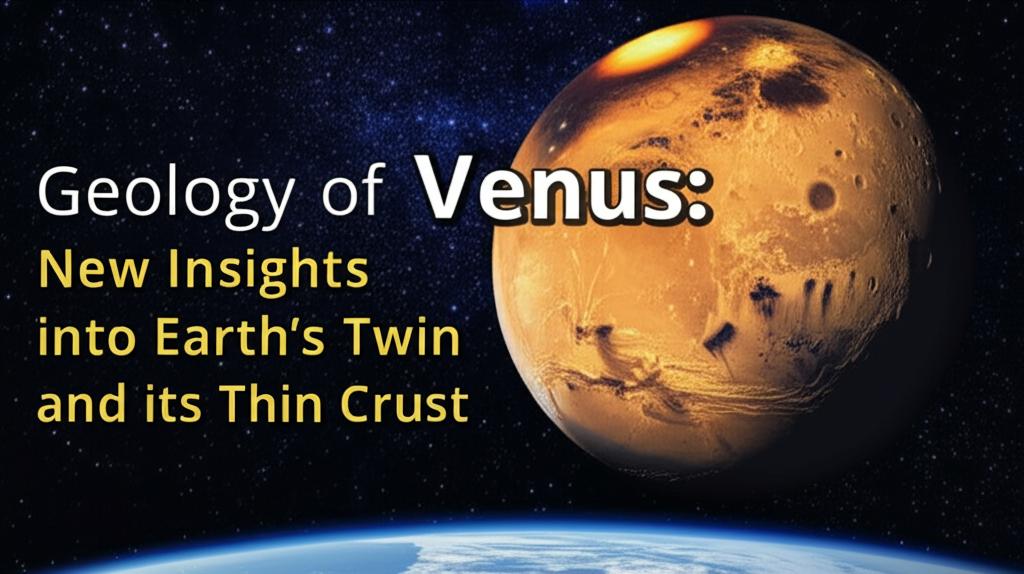Recent discoveries have shed new light on the geology of Venus, particularly regarding its surprisingly thin crust and what this implies for the planet's internal processes and history.
Venus, often dubbed Earth's "twin" due to its similar size, mass, and composition, has a dramatically different surface environment and geological evolution. Unlike Earth, Venus does not currently exhibit global plate tectonics, the process that shapes much of Earth's surface. Instead, its crust was long thought to be thick and stagnant. However, recent NASA-funded research and analyses of data from past missions like Magellan are challenging this view.
A Surprisingly Thin Crust:New studies indicate that Venus's crust is significantly thinner than previously believed. Modeling suggests an average thickness of about 25 miles (40 kilometers) and a maximum of around 40 miles (65 kilometers). This is considered surprisingly thin given Venus's harsh surface conditions and lack of Earth-style plate tectonics, which on our planet helps regulate crustal thickness through subduction.
Mechanisms Shaping the Thin Crust:Scientists propose a "crustal metamorphism" process to explain this thinness. As the crust thickens over time, the bottom layer becomes so dense due to pressure and heat that it either breaks off and sinks into the mantle or melts directly. This process of recycling material back into the planet's interior can drive volcanic activity and help explain some of the dramatic surface features observed on Venus.
Another theory gaining traction is the possibility of crustal convection. This suggests that Venus's crust, which could be between 30 and 90 kilometers thick in various locations, might be continuously churning. This convection within the crust itself, as opposed to Earth's mantle convection which drives plate tectonics, could be a significant mechanism for heat loss and a driver for the planet's extensive volcanism, with an estimated 85,000 volcanoes. This process would be more likely if the base of the crust is undergoing melting.
Implications for Volcanism and Tectonics:The thin crust has significant implications for Venus's volcanic and tectonic activity. A thinner lithosphere (the rigid outer part of the planet, including the crust and upper mantle) allows more heat to escape from the planet's interior. This enhanced heat flow is often associated with increased volcanic activity. Indeed, scientists have found evidence of ongoing volcanic activity on Venus by analyzing archival data from the Magellan mission, which mapped the planet in the early 1990s. These studies have identified surface changes, such as new rock formations from lava flows, indicating recent eruptions. Some research suggests that Venus's volcanic activity could be comparable to Earth's.
While Venus lacks Earth-like plate tectonics, it does exhibit tectonic features to a limited extent, including "deformation belts" composed of folds and faults. The study of quasi-circular geological features called "coronae" suggests these are locations where active geology is shaping Venus's surface today, possibly related to areas where the lithosphere is particularly thin and heat is escaping. Some research even suggests these coronae might represent a form of localized, perhaps early-stage, tectonic activity.
Connections to Early Earth:The geological features and processes being uncovered on Venus, such as the formation of highland plateaus known as "tesserae," show striking similarities to what scientists believe occurred on early Earth. The Ishtar Terra highlands, for example, may have been raised by craton-like formation mechanisms – processes similar to those that created Earth's earliest continents. Venus's hot, thinner lithosphere might serve as an analogue for early Earth conditions, offering insights into how our own planet's continents may have formed before robust plate tectonics took hold.
Atmospheric Evolution:The geological activity on Venus, particularly massive volcanic outgassing over millions of years, is thought to have played a crucial role in transforming its atmosphere from potentially Earth-like conditions to the extreme greenhouse world observed today, with a dense carbon dioxide atmosphere and surface temperatures hot enough to melt lead.
Ongoing Research and Future Missions:The ongoing analysis of archival data, coupled with sophisticated computational modeling, continues to refine our understanding of Venus. Future missions like NASA's DAVINCI and VERITAS, and ESA's EnVision, are expected to provide even more detailed insights into Venus's geological history, its thin crust, internal dynamics, and its divergent evolutionary path compared to Earth. These missions aim to further investigate the planet's surface composition, geological activity, and atmospheric processes.
In summary, recent findings paint a picture of a geologically dynamic Venus with a surprisingly thin crust. This thinness is likely maintained by processes of crustal recycling and possibly crustal convection, which fuel significant volcanic activity and shape its unique surface features. These discoveries not only reshape our understanding of Earth's twin but also offer valuable clues about the evolution of rocky planets, including the early history of Earth itself.

